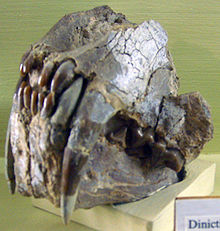- Dinictis
-
Dinictis
Temporal range: Late Eocene–Early OligoceneDinictis skeleton Scientific classification Kingdom: Animalia Phylum: Chordata Class: Mammalia Order: Carnivora Family: Nimravidae Subfamily: Nimravinae Genus: Dinictis Species Dinictis cyclops
Dinictis felina
Dinictis priseus
Dinictis squalidensDinictis is an extinct genus of the family Nimravidae, subfamily Nimravinae endemic to North America during the Eocene-Oligocene epochs (30.8—20.6 mya), existing for approximately 10.2 million years.[1]
Contents
Taxonomy
Dinictis was named by Joseph Leidy (1854). Its type is Dinictis felina. It was assigned to Nimravidae by Leidy (1854); and to Nimravinae by Flynn and Galiano (1982), Bryant (1991) and Martin (1998).[2][3]
Morphology
Dinictis, also known as "false saber-toothed cats", had a sleek body 1.1 metres (3.6 ft) long, short legs 0.6 metres (2.0 ft) high with only incompletely retractable claws, powerful jaws, and a long tail. It was very similar to its close relative, Hoplophoneus. The shape of its skull is reminiscent of a felid skull rather than of the extremely short skull of the Machairodontinae. Compared with those of the more recent machairodonts, its upper canines were relatively small, but they nevertheless distinctly protruded from its mouth. Below the tips of the canines its lower jaw spread out in the form of a lobe.
 Skeleton of D. felina in the Field Museum of Natural History.
Skeleton of D. felina in the Field Museum of Natural History.
Dinictis walked plantigrade (flat-footed), unlike modern felids. It looked like a small leopard and evidently its mode of life was similar to that of a leopard. It was probably not so particular about its food as its descendants, since reduction of the teeth was still in the early stages and Dinictis had not forgotten how to chew. Despite this, in its own environment it would have been a powerful predator.
Ecology
It lived in the plains of North America and Canada with fossils found in Saskatchewan and Colorado, Montana, Nebraska, South Dakota, North Dakota, Wyoming, and Oregon in the United States. Dinictis likely evolved from an early Miacis-like ancestor which lived in the Paleocene.
References
- ^ PaleoBiology Database: Dinictis, basic info
- ^ J. J. Flynn and H. Galiano. 1982. Phylogeny of early Tertiary Carnivora, with a description of a new species of Protictis from the middle Eocene of northwestern Wyoming. American Museum Novitates
- ^ H. N. Bryant. 1991. Phylogenetic relationships and systematics of the Nimravidae (Carnivora). Journal of Mammalogy.
Benes, Josef. Prehistoric Animals and Plants. Pg. 204. Prague: Artua, 1979.
This article related to prehistoric animals from order Carnivora is a stub. You can help Wikipedia by expanding it.



